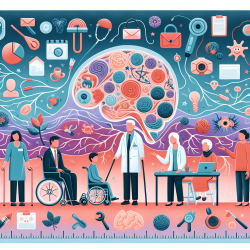Understanding Metachromatic Leukodystrophy: Insights from Caregiver Interviews
Metachromatic leukodystrophy (MLD) is a rare, autosomal recessive lysosomal storage disease characterized by progressive loss of motor and cognitive functions. A recent study, "Insights into the natural history of metachromatic leukodystrophy from interviews with caregivers," offers valuable insights into the disease's progression and symptomatology, gathered through interviews with caregivers of MLD patients. This blog explores the key findings of the study and how they can inform practitioners working with MLD patients.
Key Findings from the Study
The study involved interviews with 32 caregivers of patients diagnosed with either late-infantile or juvenile MLD. The caregivers provided detailed accounts of the onset, progression, and challenges associated with MLD. Here are some significant findings:
- Symptom Onset: Late-infantile MLD typically begins with gross motor function impairments, such as difficulties in walking, while juvenile MLD often starts with cognitive or behavioral changes.
- Diagnosis Delays: There is often a delay in diagnosing MLD, especially in juvenile cases, due to the variability in symptoms and initial misdiagnoses such as attention deficit disorder (ADD).
- Disease Progression: Late-infantile MLD progresses rapidly, with significant functional decline occurring within the first few years. In contrast, juvenile MLD has a more protracted progression, with cognitive and motor declines occurring over several years.
- Therapeutic Interventions: Hematopoietic stem cell transplantation (HSCT) has shown variable outcomes, with some juvenile MLD patients experiencing stabilization or improvement in motor functions.
Implications for Practitioners
Understanding the natural history of MLD is crucial for practitioners involved in the care of affected individuals. Here are some ways practitioners can use the study's findings to enhance their practice:
- Early Identification: Recognizing early symptoms, particularly in gross motor and cognitive functions, can facilitate timely diagnosis and intervention.
- Tailored Interventions: Given the variability in disease progression, interventions should be personalized, taking into account the specific symptoms and needs of each patient.
- Family Support: Caregivers play a critical role in managing MLD. Providing them with resources and support can improve patient outcomes and caregiver well-being.
- Further Research: Encourage further research into genetic and environmental factors influencing MLD progression and the efficacy of emerging therapies such as gene therapy.
Conclusion
The insights gained from caregiver interviews offer a deeper understanding of MLD and highlight the importance of early diagnosis and personalized care strategies. Practitioners are encouraged to incorporate these findings into their practice and contribute to ongoing research efforts to improve the quality of life for individuals with MLD.
To read the original research paper, please follow this link: Insights into the natural history of metachromatic leukodystrophy from interviews with caregivers.










